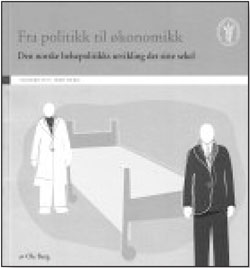Book review: Can market forces save the welfare state?
Michael 2006; 3: 100–2.
Berg O. Fra politikk til økonomikk. Den norske helsepolitikks utvikling det siste sekel. Oslo: Den norske lægeforening, 2006. 115 pp. NOK 150. ISBN: 978–82–8070–036–6.
[Berg O. From politics to economics. The development of Norwegian health politics during the last century. Oslo: The Norwegian Medical Association, 2006.]

«If we study the health politics in Norway very concrete, one can easily become overwhelmed and scared away from trying to find the longer lines. In this work these lines are the main objects for attention».
Such reads the blurb of this well designed, though not easily read book on the politics behind the health services in Norway during the 20th century.
Professor Ole Berg (b.1944), a political scientist, is a prominent person in Norwegian health care. For more than 20 years he has been professor of health administration at the University of Oslo. Berg was the founding father of a Master programme in health administration in Oslo and he has published several books and papers on health politics and medical sociology.
Hardly any part of the Norwegian society has changed so much during the 20th century as health care services. At the beginning of the century only 0.3 % of a tiny gross national product (GNP) was spent on health services. 100 years later, a 10 % share of a GNP that had increased 25 fold (and is among the highest in the world), is used for the same purpose!
Reflecting the developments of the last century, 30 text pages of the book cover the first 70 years, and 70 pages cover the last 30 years.
Establishing a national health service was an important part of the nation building project when the union with Sweden was dissolved in 1905. The first health insurance legislation was approved by the Norwegian Parliament (Stortinget) in 1909. Berg sees the comprehensive Act on social insurance of 1967 as the completion of the Norwegian welfare state. Until then, redistribution of resources was the main issue, as part of the left oriented planned economy mainly implemented by the Norwegian Labour Party (Arbeiderpartiet). The Act of hospitals of 1969 included a very expansive funding system for new hospitals and this combined with other increases in health care costs gave rise to serious concern. Warning bells were ringing, as Ole Berg words it. Greater effectiveness became an aim across political borders. Berg describes three phases in the process initiated to cope with the increasing costs.
The first phase started with the White Paper of 1974 «On hospital development etc in a regionalised health care system» (St. meld. nr. 9 (1974–75) Om sykehusutbygging m.v. i et regionalisert helsevesen), characterised by Berg as the most «thorough report on health politics after the Second World War». This White Paper introduced the principle of Lowest Effective Level of Care (in Norwegian abbreviated LEON). Planned economy was still the basis, and the reimbursement system for funding of hospital services was in 1980 changed to fixed budgets.
The second phase, in the 1980ies was, according to the general political trend of the time, based on more liberal political ideas and increasing use of market mechanisms. Freedom of choice for the consumer (read: patient) was a coming mantra. Politicising reforms should reduce the medical impact on the management of health institutions, but it was not easy for nonmedical leaders to take charge. As a non-medical manager told Ole Berg in the 1980ies: «When I meet with my medical consultants, I have this feeling that they look down at me. And what is even worse, I realise that I, myself, look up to them.»
In the third phase, from the mid-1990ies, the health care services became «depoliticised» and there was a real breakthrough for liberal ideas. Paradoxically, it was the Labour Party that implemented this system, which included achievement based funding and the so-called diagnosis related groups’ system (DRG). The process culminated in 2002 when the responsibility for specialist health services was taken away from the 19 counties and given to five newly established Regional Health Enterprises (Regionale helseforetak, RHF). These enterprises have become extremely powerful institutions and their independence and lack of cooperation are among the greatest threats to a true national health policy in Norway at the beginning of the 21th century. The current centre/leftist government now in 2006 tries to regain some control of these billion-institutions by nominating politicians at their boards.
Ole Berg describes the industry-like models for running the health care system as «right wing politics». And he argues that such means have been introduced to protect the basic principles of justice and equality named by Berg as «left wing politics». The development within the health care sector over the last decades is closely related to the so-called «New Public Management», a kind of «private» way to run public institutions.
Ole Berg shares an enormous amount of figures and factual information with his readers. But he writes in a complicated style and many paragraphs must be read over again to catch his message. If sufficient time is spent on the book, there are interesting matters to learn.
There are, however, surprising weaknesses. Berg’s division between political «right» and «left» seems like an oversimplification of Norwegian health politics, which until the end of the 20th century hardly had any clear and strong internal antagonisms. In a country famous for its primary care it is also strange that the analysis almost exclusively is oriented towards the specialist health services.
And most surprisingly is perhaps Berg’s passive and defeatist approach to the current challenges in Norwegian health care. It would be tempting to ask him the one million dollar question: Will we ever again have a true national health service in Norway, and can political control over the publicly funded health care services ever be recaptured?
Professor of community medicine
Department of Public Health and General Practice
Norwegian University of Science and Technology
N-7489 Trondheim
Norway
magne.nylenna@helsebiblioteket.no
